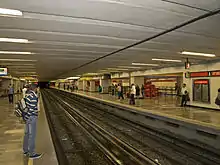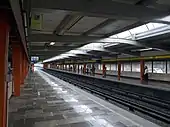Instituto del Petróleo metro station
Instituto del Petróleo (![]() Spanish pronunciation ; Spanish for "Petroleum Institute") is a Mexico City Metro transfer station in Gustavo A. Madero, Mexico City. It is a combined underground and at-grade station with two side platforms each, along Lines 5 (the Yellow line) and 6 (the Red line). Instituto del Petróleo is located between Politécnico and Autobuses del Norte on Line 5, and between Vallejo and Lindavista on Line 6. It serves the colonias Valle del Tepeyac, San Bartolo Atepehuacan, and Nueva Industrial. The station's pictogram depicts an oil derrick, and its name is on account of its proximity to the Mexican Petroleum Institute headquarters.
Spanish pronunciation ; Spanish for "Petroleum Institute") is a Mexico City Metro transfer station in Gustavo A. Madero, Mexico City. It is a combined underground and at-grade station with two side platforms each, along Lines 5 (the Yellow line) and 6 (the Red line). Instituto del Petróleo is located between Politécnico and Autobuses del Norte on Line 5, and between Vallejo and Lindavista on Line 6. It serves the colonias Valle del Tepeyac, San Bartolo Atepehuacan, and Nueva Industrial. The station's pictogram depicts an oil derrick, and its name is on account of its proximity to the Mexican Petroleum Institute headquarters.
Instituto del Petróleo station opened on 30 August 1982 with service on Line 5 northward toward Politécnico. West service on Line 6 toward El Rosario started on 21 December 1983. In the station, there is a collection of sculptures titled Petróleo, made of oil drums and created by Mexican artist Ernesto Paulsen Camba.
Location

Instituto del Petróleo is a metro transfer station in the Gustavo A. Madero borough, in northern Mexico City. The station lies on Eje Central Lázaro Cárdenas, also known as 100 Metros Avenue, and serves colonias Valle del Tepeyac, San Bartolo Atepehuacan, and Nueva Industrial. Within the system, it lies between Politécnico and Autobuses del Norte stations on Line 5; on Line 6, between Vallejo and Lindavista stations.[2] The area is serviced by a Metrobús station, named Instituto del Petróleo (Line 6),[3] and by Line 1 (formerly Line A) of the trolleybus system.[4]
Exits
There are six exits:[2]
- Northeast: Eje Central Lázaro Cárdenas (100 Metros Avenue) and Masagua street, colonia Valle del Tepeyac (Line 5).
- Northwest: 100 Metros Avenue and Masagua street, colonia Valle del Tepeyac (Line 5).
- Southeast: 100 Metros Avenue and Otavalo street, colonia San Bartolo Atepehuacan (Line 6).
- Southwest: 100 Metros Avenue and Poniente 128 street, colonia San Bartolo Atepehuacan (Line 6).
- North: Poniente 134 street, colonia Nueva Industrial (Line 6).
- South: Poniente 134 street, colonia Nueva Industrial (Line 6).
Landmarks
Inside Instituto del Petróleo station, there are seven sculptures specifically created for the station. The collection, made of wrought iron oil drums, is named Petróleo (1986) and was created by Mexican sculptor Ernesto Paulsen Camba.[5][6]
History and construction

Line 5 of the Mexico City Metro was built at grade by Grupo ICA;[7] Instituto del Petróleo Line 5 opened on 30 August 1982, on the first day of the Politécnico–Pantitlán service.[8][9] In June 2006, Metro authorities replaced the railroad switches;[10] in 2008, they gave maintenance to the station's roof.[11]
Line 6 of the Mexico City Metro was built underground[12] by Cometro, a Grupo ICA subsidiary;[13] the Vallejo–Instituto del Petróleo interstation tunnel is 755 m (2,477 ft) long, while the Instituto del Petróleo–Lindavista tunnel measures 1,258 m (4,147 ft).[14] Instituto del Petróleo Line 6 opened on 21 December 1983, on the first day of the El Rosario–Instituto del Petróleo service. On 8 July 1986, the service toward Martín Carrera started.[15]
The passenger transfer tunnel that connects both lines has an approximate length of 500 m (1,640 ft).[16]
The station's pictogram depicts an oil derrick and its name references the Mexican Petroleum Institute, whose headquarters are in the zone;[2] there is an Internet café inside the facilities.[2]
Incidents
On 19 July 2018, a 16-year-old man was stabbed with a pair of scissors by a 40-year-old man on the station platforms. The injury did not warrant hospitalization and the agressor was referred to the Public Prosecutor's Office.[17] On 8 November 2020, Instituto del Petróleo, Politécnico, and Lindavista stations were vandalized during feminist demonstrations; walls, screens, handrails, a train, and a mural were damaged and graffitied.[18]
Ridership
In 2019, Instituto del Petróleo station had an overall ridership of 3,398,142 passengers.[1] For Line 5, the ridership was 2,215,325 passengers (6,069 per day),[1] which was an increase of 40,310 passengers compared to 2018.[19] For Line 6, the station had a ridership of 1,182,817 passengers (3,240 per day),[1] which was a decrease of 40,176 passengers compared to 2018.[19]
In 2019, the Line 5 station was the 180th busiest of the system's 195 stations, and the line's 10th busiest. The Line 6 station was the 193rd busiest in the system and the line's 10th busiest.[1]
|
| ||||||||||||||||||||||||||||||||||||||||||||||||||||||||||||||||||||||||||||||||||||||||||||||||||||||||||||||||||||||||||
References
- "Afluencia de estación por línea 2019" (in Spanish). Sistema Transporte Colectivo Metro. 2020. Archived from the original on 8 April 2020. Retrieved 3 May 2020.
- "Instituto del Petróleo" (in Spanish). Sistema Transporte Colectivo Metro. Archived from the original on 17 February 2020. Retrieved 21 November 2020.
- "Mapa completo del sistema" [Complete system map] (in Spanish). Mexico City Metrobús. Archived from the original on 11 January 2020. Retrieved 23 November 2020.
- "Línea 1" [Line 1] (in Spanish). Servicio de Transportes Eléctricos. Archived from the original on 29 February 2020. Retrieved 24 December 2020.
- Ventura, Abida (21 December 2020). "El Metro: el gran museo "underground" del DF" [Metro: Mexico City's big "underground" museum]. El Universal (in Spanish). Archived from the original on 28 July 2018. Retrieved 22 December 2020.
- Espino Arévalo, Fernando (12 November 2013). "Proposición con punto de acuerdo por el que se exhorta a la Comisión de Presupuesto y Cuenta Pública de la Asamblea Legislativa del Distrito Federal, para que en el Presupuesto de Egresos del Distrito, Federal correspondiente al ejercicio fiscal 2014, se asignen recursos al Sistema de Transporte Colectivo Metro para llevar a cabo la preservación, conservación y restauración de los bienes culturales ubicados en sus instalaciones" [Proposal with a consensus that urges the Budget and Public Account Commission of the Federal District Legislative Assembly to allocate resources in the Federal District Expenditure Budget for fiscal year 2014 to the Sistema de Transporte Colectivo Metro to carry out the preservation, conservation and restoration of the cultural assets located in its facilities] (PDF) (in Spanish). Legislative Assembly of the Federal District. p. 4. Archived (PDF) from the original on 27 November 2020. Retrieved 22 December 2020.
- "Línea 5, Ciudad de México" (in Spanish). iNGENET Infraestructura. 20 July 2009. Archived from the original on 2 September 2014. Retrieved 15 April 2020.
- Pérez Cisneros, Tonatiuh (7 May 2018). ""El 8", el aterrador sitio del Metro Instituto del Petróleo" ["The 8", the scary location at Instituto del Petróleo metro station] (in Spanish). Reversos.mx. Archived from the original on 25 August 2020. Retrieved 23 August 2020.
- Chávez García, Luis Alberto (1 June 2016). "Dip. Ana Juana Ángeles Valencia" [Deupty Ana Juana Ángeles Valencia] (PDF) (in Spanish). Legislative Assembly of Mexico City. p. 2. Archived (PDF) from the original on 25 August 2020. Retrieved 23 August 2020.
- "Cerrarán el viernes tres estaciones de la línea 5 del Metro" [Three Line 5 stations will be closed next Friday]. La Jornada (in Spanish). 13 June 2006. Archived from the original on 25 August 2020. Retrieved 23 August 2020.
- "Marzo 28 08" [March 28 08]. Mexico City Official Journal (in Spanish). 28 March 2008. p. 1. Archived from the original (PDF) on 25 August 2020. Retrieved 23 August 2020.
- "Instituto del Petróleo Metro Station (Línea 6) (Mexico City, 1983)". Structurae.net. Archived from the original on 23 December 2020. Retrieved 21 November 2020.
- "Línea 6, Ciudad de México" (in Spanish). iNGENET Infraestructura. 20 July 2009. Archived from the original on 20 June 2020. Retrieved 22 December 2020.
- Gamez Rojas, Marlen (2010). "Análisis de riesgos de incendio en el Sistema de Transporte Colectivo Metro" [Analysis of fire risks in the Sistema de Transporte Colectivo Metro] (PDF) (in Spanish). Escuela Superior de Ingeniería Mecánica y Eléctrica. Instituto Politécnico Nacional. p. 27–28. Archived (PDF) from the original on 23 November 2020.
- "¿Quieres festejar al Metro? ¿Qué tal un vagón lleno? Estas son las estaciones más concurridas" [Do you want to celebrate the Metro? What about a full car? These are the busiest stations] (in Spanish). El Financiero. Archived from the original on 23 December 2020. Retrieved 22 December 2020.
- "Transbordos en el Metro ¿una opción para ejercitarte?" [Metro transfer, a workout option?]. Milenio (in Spanish). 12 January 2018. Archived from the original on 17 January 2019. Retrieved 28 May 2020.
- "Apuñalan a menor de edad en estación del Metro Instituto del Petróleo" [Minor stabbed in Instituto del Petróleo metro station] (in Spanish). El Big Data. 19 July 2018. Archived from the original on 23 December 2020. Retrieved 22 December 2020.
- López, Jonás (8 November 2020). "Encapuchadas hacen destrozos en estaciones de L5 del Metro" [Masked female protesters shatter L5 metro stations]. Excélsior (in Spanish). Mexico City. Archived from the original on 9 November 2020. Retrieved 8 November 2020.
- "Afluencia de estación por línea 2018" (in Spanish). Sistema Transporte Colectivo Metro. 2019. Archived from the original on 6 June 2019. Retrieved 7 April 2020.
- "Afluencia de estación por línea 2017" (in Spanish). Sistema Transporte Colectivo Metro. 2019. Archived from the original on 3 May 2020. Retrieved 3 May 2020.
- "Afluencia de estación por línea 2016" (in Spanish). Sistema Transporte Colectivo Metro. 2017. Archived from the original on 3 May 2020. Retrieved 3 May 2020.
- "Afluencia de estación por línea 2015" (in Spanish). Sistema Transporte Colectivo Metro. 2016. Archived from the original on 3 May 2020. Retrieved 6 May 2020.
- "Afluencia de estación por línea 2014" (in Spanish). Sistema Transporte Colectivo Metro. 2015. Archived from the original on 3 May 2020. Retrieved 6 May 2020.
- "Afluencia de estación por línea 2013" (in Spanish). Sistema Transporte Colectivo Metro. 2014. Archived from the original on 3 May 2020. Retrieved 6 May 2020.
- "Afluencia de estación por línea 2012" (in Spanish). Sistema Transporte Colectivo Metro. 2013. Archived from the original on 3 May 2020. Retrieved 6 May 2020.
- "Afluencia de estación por línea 2011" (in Spanish). Sistema Transporte Colectivo Metro. 2012. Archived from the original on 6 May 2020. Retrieved 6 May 2020.
- "Afluencia de estación por línea 2010" (in Spanish). Sistema Transporte Colectivo Metro. 2011. Archived from the original on 6 May 2020. Retrieved 6 May 2020.
External links
 Media related to Instituto del Petróleo (station) at Wikimedia Commons
Media related to Instituto del Petróleo (station) at Wikimedia Commons- "Metro Instituto del Petróleo" (in Spanish). At the Official Guide to Mexico City.

